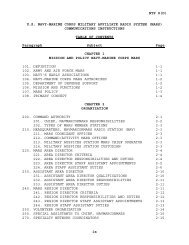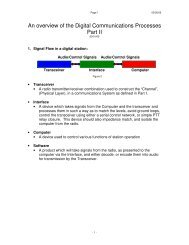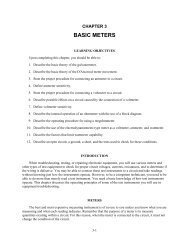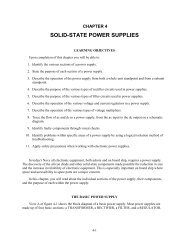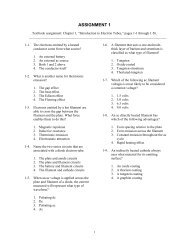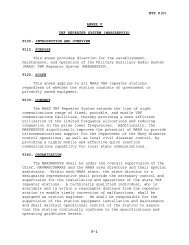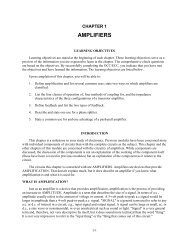conduction on the negative half-cycle decreases the gain of that half-cycle. The overall effect of allowingcathode biasing to follow the input signal is to decrease the gain of the circuit with ac inputs.This problem can be overcome by installing C k . The purpose of C k is to maintain the cathode biasvoltage at a constant level. In common usage, the action of C k is referred to as "bypassing the ac signal toground."The action of C k will be explained using figure 1-23. View A shows the circuit under quiescentconditions. With some conduction through the tube, the cathode and the tops of R k and C k are at +10volts.Figure 1-23.—Effect of the bypass capacitor.In view B, the positive-going signal is applied to the grid. This causes increased conduction throughthe tube, which attempts to drive the cathode to +20 volts. But notice that the top of C k is still at +10 volts(remember capacitors oppose a change in voltage). The top plate of C k is, in effect, 10 volts negative inrelation to the top of R k . The only way that C k can follow the signal on the top of R k (+20 volts) is tocharge through the tube back to the source, from the source to the lower plate of C k . When C k chargesthrough the tube, it acts as the source of current for the cathode. This causes the cathode to remain at +10volts while the capacitor is charging.View C of the figure shows the same signal. Under these conditions, conduction through R k willdecrease. This will cause a decrease in current flow through R k . Decreased current means decreasedvoltage drop. The top of R k will try to go to +5 volts. C k must now go more negative to follow the top ofR k . To do this, current must flow from C k through R k , to the top plate of C k . This discharging of C k willincrease current flow through R k and increase the voltage drop across R k , forcing the top to go morepositive. Remember, the voltage drop is due to current flow through the resistor. (The resistor could careless if the current is caused by conduction or capacitor action.) Thus, the cathode stays at +10 voltsthroughout the capacitor-charge cycle.There is one point that we should make. C k and R k are in parallel. You learned from previous studythat voltage in a parallel circuit is constant. Thus, it would seem impossible to have the top of R k at onevoltage while the top plate of C k is at another. Remember, in electronics nothing happens instantaneously.There is always some time lag that may be measured in millionths or billionths of seconds. The action ofC k and R k that was just described takes place within this time lag. To clarify the explanation, the voltagesused at the components R k and C k were exaggerated. Long before a 10-volt differential could existbetween the tops of R k and C k , C k will act to eliminate this voltage differential.1-32
The capacitor, then, can be said to regulate the current flow through the bias resistor. This action isconsidered as BYPASSING or eliminating the effect of the ac input signal in the cathode. For allpractical purposes, you can assume that ac flows through the capacitor to ground. But, remember, ac onlyappears to flow across a capacitor. In reality the ac signal is shunted around the capacitor.There are two disadvantages associated with cathode biasing. To maintain bias voltage continuously,current must flow through the tube, and plate voltage will never be able to reach the maximum value ofthe source voltage. This, in turn, limits the maximum positive output for a negative input signal(remember the 180º inversion). In addition, maximum plate voltage is decreased by the amount ofcathode-biasing voltage. What this means is that you can't get something for nothing. If the cathode isbiased at +20 volts, this voltage must be subtracted from the plate voltage. As an example, consider atriode with a 10,000 ohm plate resistor and a +300 volts dc source voltage. If a current of 2 milliamperesflows through the tube under quiescent conditions, 20 volts are dropped across the plate-load resistor. Themaximum plate voltage is then 300 volts - 20 volts = 280 volts dc. Now, consider the 20-volt droppedacross the cathode resistor. Plate voltage becomes 280 volts - 20 volts = 260 volts. To understand this alittle more thoroughly, look at figure 1-24. In view A, the source voltage is 300 volts dc. There are twoways that this voltage can be looked at; either the plate is at +300 volts and the cathode is at 0 volts(ground), or the plate is at +150 volts and the cathode is at -150 volts. In electronics, it is commonpractice to assume that the plate is at +300 volts while the cathode is at 0 volts. To simplify thisdiscussion, we will assume that the plate is at +150 volts, and the cathode is at -150 volts. The potentialdifference between the plate and the cathode is 300 volts. If a plate-load resistor is installed, as shown inview B, 20 volts are dropped by R L. The potential difference between the plate and the cathode is now280 volts. In view C, R k has now been placed in the same circuit. R k drops 20 volts. Therefore, the effectof cathode biasing is to reduce the maximum positive signal that the circuit can produce. In this case, themaximum positive signal has been reduced by 20 volts. Despite these disadvantages, cathode biasing hastwo main advantages. It is simple and economical.Grid-Leak BiasingFigure 1-24.—Loss due to cathode biasing.The second type of self-biasing to be discussed is GRID-LEAK BIAS. As the name implies, biasvoltage is developed in the grid leg portion of the circuit. Bias voltage in this type of biasing is derived byallowing the positive input signal to draw grid current through a circuit made up of a resistor and acapacitor. There are two types of grid-leak bias commonly in use: SHUNT TYPE and SERIES TYPE.Because shunt type grid-leak biasing is the simplest, we will discuss it first. Figure 1-25 depicts asimplified triode circuit using the shunt-type grid-leak biasing. Before we begin the explanation of shunt1-33





